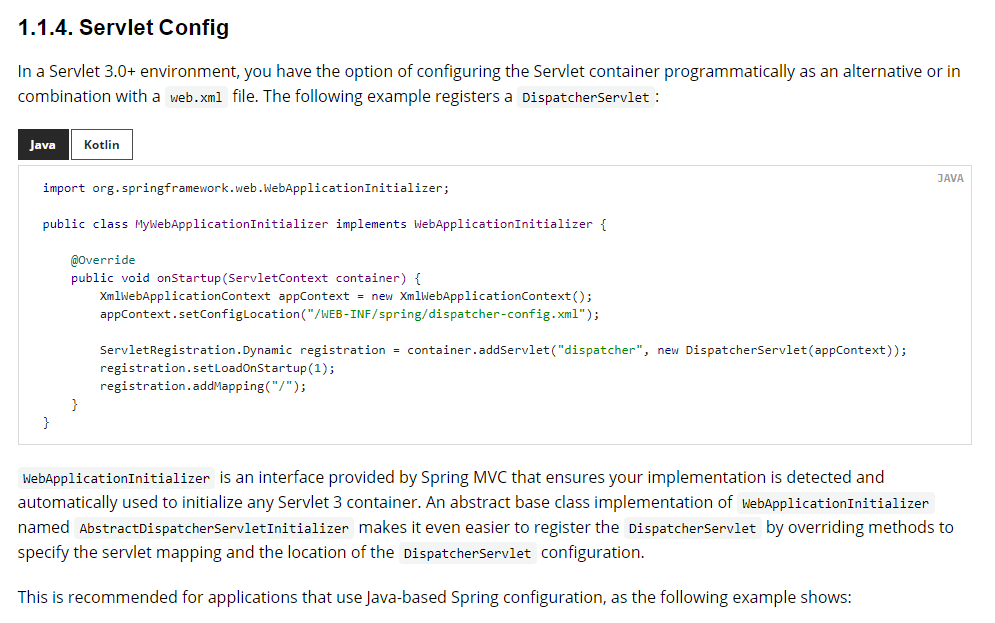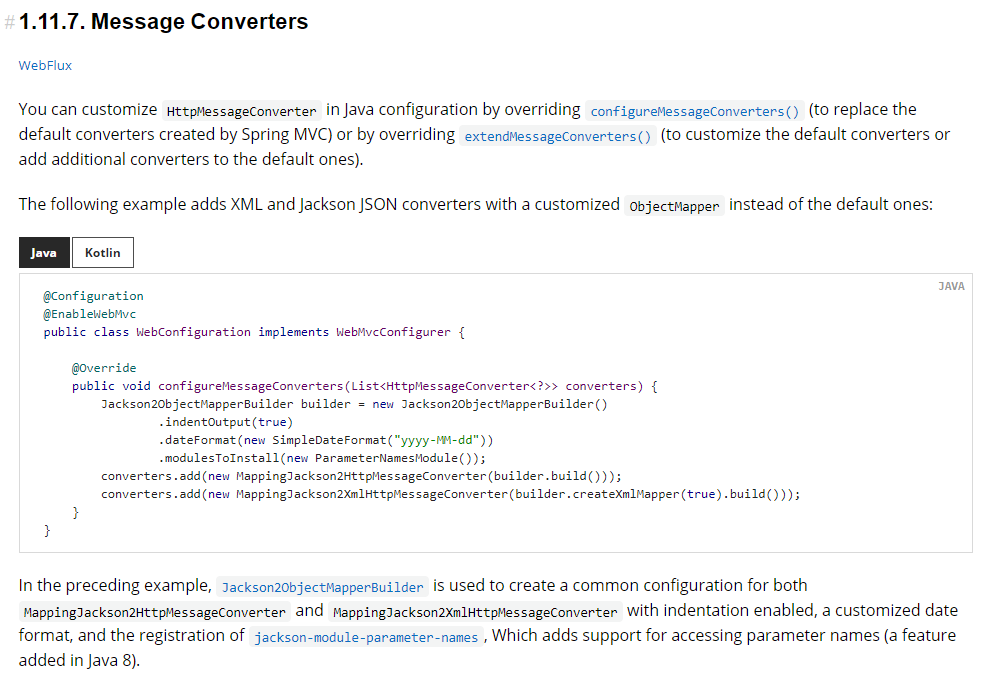springmvc零xml配置原理
springmvc零xml配置原理与Servlet3.0SPI机制
这里引用另一位博主的文章,比较图文并茂一点,但是他的写法会导致一点问题,在文章结尾会说明。地址:https://blog.csdn.net/weixin_44051223/article/details/106127211
传统springmvc项目,如果要采用xml文件的方式配置,则需要web.xml、spring-mvc.xml文件。
web.xml文件用来引入springmvc的配置文件contextConfigLocation,以及spring环境org.springframework.web.context.ContextLoaderListener
web.xml:
<!-- spring环境的初始化--> <listener> <listener-class>org.springframework.web.context.ContextLoaderListener</listener-class> </listener> <servlet> <servlet-name>springmvc</servlet-name> <servlet-class>org.springframework.web.servlet.DispatcherServlet</servlet-class> <init-param> <!-- 引入springmvc的配置文件--> <param-name>contextConfigLocation</param-name> <param-value>spring-mvc.xml</param-value> </init-param> <!-- 加载顺序--> <load-on-startup>1</load-on-startup> </servlet> <servlet-mapping> <servlet-name>springmvc</servlet-name> <url-pattern>*.do</url-pattern> </servlet-mapping>
spring-mvc.xml文件:
<!--启用spring的一些annotation --> <context:annotation-config/> <!-- 配置注解驱动 可以将request参数绑定到controller参数上 --> <mvc:annotation-driven/> <!-- 对模型视图名称的解析,即在模型视图名称添加前后缀(如果最后一个还是表示文件夹,则最后的斜杠不要漏了) 使用JSP--> <!-- 默认的视图解析器 在上边的解析错误时使用 (默认使用html)- --> <bean id="defaultViewResolver" class="org.springframework.web.servlet.view.InternalResourceViewResolver"> <property name="viewClass" value="org.springframework.web.servlet.view.JstlView"/> <property name="prefix" value="/WEB-INF/view/"/><!--设置JSP文件的目录位置--> <property name="suffix" value=".jsp"/> <property name="exposeContextBeansAsAttributes" value="true"/> </bean> <!-- 自动扫描装配 --> <context:component-scan base-package="com.XXX"/>
那么,现在提供一种方式,可以不用配置任何的xml文件,也同样能搭建起springmvc项目。
现在一起来看一下spring官网提供的文档描述:
https://docs.spring.io/spring-framework/docs/current/reference/html/web.html#mvc-servlet-config

这里可以看到需要实现一个接口的onStartup方法
public class MyWebApplicationInitializer implements WebApplicationInitializer { //实现0XML //类实现WebApplicationInitializer【spring官方提供的方法。用于加载spring容器】 //tomcat启动时会调用onStartup方法? @Override public void onStartup(ServletContext servletContext) { //传入一个ServletContext:web上下文对象。web.xml能做的事她都能做 // Load Spring web application configuration AnnotationConfigWebApplicationContext context = new AnnotationConfigWebApplicationContext(); context.register(AppConfig.class); // Create and register the DispatcherServlet DispatcherServlet servlet = new DispatcherServlet(context); ServletRegistration.Dynamic registration = servletContext.addServlet("app", servlet); registration.setLoadOnStartup(1); registration.addMapping("*.do"); }
这里只是配置了一个DispatcherServlet,那试图解析器在哪里配置呢?再回到官方文档

其实这里就是用来配置视图解析器的地方
写一个AppConfig类,作为Springmvc的配置类,实现
WebMvcConfigurer
@Configuration @ComponentScan("com") @EnableWebMvc public class AppConfig implements WebMvcConfigurer { /*** * 配置视图解析 * @param registry */ @Override public void configureViewResolvers(ViewResolverRegistry registry) { registry.jsp("/page/", ".html"); } /** * 配置一个消息转换器[对象的转换] * @param converters */ @Override public void configureMessageConverters(List<HttpMessageConverter<?>> converters) { for (HttpMessageConverter<?> converter : converters) { System.out.println(converter); } FastJsonHttpMessageConverter converter = new FastJsonHttpMessageConverter(); converters.add(converter); }

WebMvcConfigurer接口一共定义了若干方法,可以对照着官网学习配置。
此时就可以编写controller类来测试零xml配置的springmvc了
@Controller public class TestController { /** * 访问普通的字符串,试图解析器会解析成对应的页面 * @return */ @RequestMapping("/str.do") public Object Test(){ return "index"; } /** * 因为返回值是一个对象,所以如果不做特殊处理,则试图解析器无法解析 * 对象嵌套是一个难点 * @param name * @param request * @param response * @return */ @RequestMapping("/model.do") @ResponseBody public Object modeltest(String name, HttpServletRequest request, HttpServletResponse response){ System.out.println("调用了modeltest"); String req_name = request.getParameter("name"); Map hashMap = new HashMap<>(); hashMap.put("key", "value"); return hashMap; } }
启动Tomcat需要一个启动类:
public class Application { public static void main(String[] args) throws ClassNotFoundException, IllegalAccessException, InstantiationException, LifecycleException, ServletException { // Tomcat tomcat = new Tomcat(); // tomcat.setPort(80); // //初始化一个context资源目录,并不会加载web的生命周期 // //Context context = tomcat.addContext("/", System.getProperty("java.io.tmpdir")); // Context context = tomcat.addContext("/", Application.class.getResource("/").getPath().replaceAll("%20"," ")); // //添加web生命周期监听器 // context.addLifecycleListener((LifecycleListener)Class.forName(tomcat.getHost().getConfigClass()).newInstance()); // tomcat.start(); // tomcat.getServer().await(); Tomcat tomcat = new Tomcat(); tomcat.setPort(80); //Context context = tomcat.addContext("/", System.getProperty("java.io.tmpdir")); tomcat.addWebapp("/",Application.class.getResource("/").getPath().replaceAll("%20"," ")); //context.addLifecycleListener((LifecycleListener) Class.forName(tomcat.getHost().getConfigClass()).newInstance()); //tomcat.addWebapp("/", System.getProperty("java.io.tmpdir")); tomcat.start(); tomcat.getServer().await(); } }
这里有一点需要注意:
如果使用引用文章的写法,即
Context context = tomcat.addContext("/", System.getProperty("java.io.tmpdir"));
context.addLifecycleListener((LifecycleListener) Class.forName(tomcat.getHost().getConfigClass()).newInstance());
会导致webapp目录下的页面与静态资源都无法访问。controller返回一个index,按道理是可以通过localhost/page/index.html访问到index.html页面。但是由于加载的是一个临时目录,所以访问不到项目的静态资源
//TODO Servlet3.0 SPI






【推荐】国内首个AI IDE,深度理解中文开发场景,立即下载体验Trae
【推荐】编程新体验,更懂你的AI,立即体验豆包MarsCode编程助手
【推荐】抖音旗下AI助手豆包,你的智能百科全书,全免费不限次数
【推荐】轻量又高性能的 SSH 工具 IShell:AI 加持,快人一步
· 基于Microsoft.Extensions.AI核心库实现RAG应用
· Linux系列:如何用heaptrack跟踪.NET程序的非托管内存泄露
· 开发者必知的日志记录最佳实践
· SQL Server 2025 AI相关能力初探
· Linux系列:如何用 C#调用 C方法造成内存泄露
· Manus爆火,是硬核还是营销?
· 终于写完轮子一部分:tcp代理 了,记录一下
· 别再用vector<bool>了!Google高级工程师:这可能是STL最大的设计失误
· 单元测试从入门到精通
· 震惊!C++程序真的从main开始吗?99%的程序员都答错了